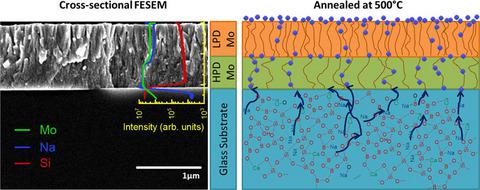当前位置:
X-MOL 学术
›
J. Am. Ceram. Soc.
›
论文详情
Our official English website, www.x-mol.net, welcomes your
feedback! (Note: you will need to create a separate account there.)
Evaluating the role of composition and local structure on alkali out‐diffusion in glasses for thin‐film solar cells
Journal of the American Ceramic Society ( IF 3.5 ) Pub Date : 2020-09-21 , DOI: 10.1111/jace.17491 Neetu Bansal 1 , Mukul Gupta 2 , Bhaskar Chandra Mohanty 1 , Kulvir Singh 1
Journal of the American Ceramic Society ( IF 3.5 ) Pub Date : 2020-09-21 , DOI: 10.1111/jace.17491 Neetu Bansal 1 , Mukul Gupta 2 , Bhaskar Chandra Mohanty 1 , Kulvir Singh 1
Affiliation

|
The presence of alkali ions has reportedly improved the performance of CIGS/CZTS–based thin‐film solar cells. The out‐diffusion of the alkali ion, in particular, Na, from the glass substrate offers a facile scalable route of supplying the alkali ions during the growth of the absorber layer. In this work, we demonstrate the diffusion of different alkali ions (Li/Na/K) from composition tuned glasses with intentionally incorporated excess alkali ions into a thin Mo film, typically used as a bottom electrode in solar cells. We also evaluate the physical, mechanical, and thermal properties of the glasses for suitability as a substrate in thin‐film deposition. The out‐diffusion of alkali ions to the overlayer is found to be critically influenced by the composition and the local structure of the glasses. The Na ions exhibit the highest extent of diffusion among the alkali ions present in glass substrates, while that for the K‐ions is the lowest. For the glasses with mixed alkali ions, the presence of Li facilitated the out‐diffusion of Na, whereas K ions appear to inhibit the same. Differently with the existing reports, we show that the activation energy and the presence of Ca ions as additional modifiers play a crucial role in the transport mechanism of the ions. In addition, the synthesized glasses exhibit hardness of the order 5‐7 GPa, density ~2.55 g cm‐3. The glass transition temperature lies between 535 and 580°C and the coefficient of thermal expansion 8.5‐10 ppm/K, which is highly suitable for use as substrates in thin‐film solar cells.
中文翻译:

评估成分和局部结构对薄膜太阳能电池玻璃中碱扩散的作用
据报道,碱离子的存在改善了基于CIGS / CZTS的薄膜太阳能电池的性能。碱离子(特别是Na)从玻璃基板中向外扩散提供了一种在吸收层生长期间提供碱离子的简便可扩展途径。在这项工作中,我们证明了不同的碱金属离子(Li / Na / K)从组成调谐的玻璃中的扩散,故意将过量的碱金属离子掺入了Mo薄膜中,通常用作太阳能电池的底部电极。我们还评估了玻璃的物理,机械和热性能,以适合作为薄膜沉积中的基材。发现碱金属离子向外层的扩散受到玻璃成分和玻璃局部结构的严重影响。在玻璃基板中存在的碱离子中,Na离子的扩散程度最高,而K-离子的扩散程度最低。对于混合碱离子的玻璃,Li的存在促进了Na的扩散,而K离子似乎抑制了钠的扩散。与现有报告不同,我们表明活化能和Ca离子作为其他改性剂的存在在离子的传输机制中起着至关重要的作用。此外,合成玻璃的硬度约为5-7 GPa,密度约为2.55 g cm 我们表明,活化能和Ca离子作为其他改性剂的存在在离子的传输机制中起着至关重要的作用。此外,合成玻璃的硬度约为5-7 GPa,密度约为2.55 g cm 我们表明,活化能和Ca离子作为其他改性剂的存在在离子的传输机制中起着至关重要的作用。此外,合成玻璃的硬度约为5-7 GPa,密度约为2.55 g cm‐3。玻璃化转变温度介于535至580°C之间,热膨胀系数为8.5-10 ppm / K,非常适合用作薄膜太阳能电池的基板。
更新日期:2020-09-21
中文翻译:

评估成分和局部结构对薄膜太阳能电池玻璃中碱扩散的作用
据报道,碱离子的存在改善了基于CIGS / CZTS的薄膜太阳能电池的性能。碱离子(特别是Na)从玻璃基板中向外扩散提供了一种在吸收层生长期间提供碱离子的简便可扩展途径。在这项工作中,我们证明了不同的碱金属离子(Li / Na / K)从组成调谐的玻璃中的扩散,故意将过量的碱金属离子掺入了Mo薄膜中,通常用作太阳能电池的底部电极。我们还评估了玻璃的物理,机械和热性能,以适合作为薄膜沉积中的基材。发现碱金属离子向外层的扩散受到玻璃成分和玻璃局部结构的严重影响。在玻璃基板中存在的碱离子中,Na离子的扩散程度最高,而K-离子的扩散程度最低。对于混合碱离子的玻璃,Li的存在促进了Na的扩散,而K离子似乎抑制了钠的扩散。与现有报告不同,我们表明活化能和Ca离子作为其他改性剂的存在在离子的传输机制中起着至关重要的作用。此外,合成玻璃的硬度约为5-7 GPa,密度约为2.55 g cm 我们表明,活化能和Ca离子作为其他改性剂的存在在离子的传输机制中起着至关重要的作用。此外,合成玻璃的硬度约为5-7 GPa,密度约为2.55 g cm 我们表明,活化能和Ca离子作为其他改性剂的存在在离子的传输机制中起着至关重要的作用。此外,合成玻璃的硬度约为5-7 GPa,密度约为2.55 g cm‐3。玻璃化转变温度介于535至580°C之间,热膨胀系数为8.5-10 ppm / K,非常适合用作薄膜太阳能电池的基板。











































 京公网安备 11010802027423号
京公网安备 11010802027423号